|
|
 |
Fiche d'espèce de Copépode |
|
|
Calanoida ( Ordre ) |
|
|
|
Clausocalanoidea ( Superfamille ) |
|
|
|
Euchaetidae ( Famille ) |
|
|
|
Paraeuchaeta ( Genre ) |
|
|
| |
Paraeuchaeta rasa Farran, 1929 (F,M) | |
| | | | | | | Syn.: | Pareuchaeta rasa Farran, 1929 (p.208, 240, Descr.F, figs.F); no Pareuchaeta rasa : C.B. Wilson, 1950 (p.283); Mauchline, 1998 (tab.42);
Euchaeta rasa : Vervoort, 1957 (p.77, 78, figs.F, Rem.); Park, 1978 (p.272, figs.F, M, Rem.); Øresland & Ward, 1993 (p.73, diet);
Ref. compl.: Hopkins, 1985 (p.197, Table 1, gut contents); Hopkins & Torres, 1988 (tab.1); Ward & Wood, 1988 (p.45, tab.1) | | | | Ref.: | | | Bradford & al., 1983 (p.51, figs.F,M, Rem.); Razouls, 1994 (p.95, figs.F, M, Rem.); Park, 1994 (p.321); 1995 (p.46, Rem.F,M, figs.F,M); Bradford-Grieve & al., 1999 (p.880, 926, figs.F) | 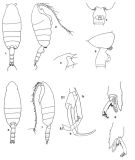 issued from : Park T.-S. in Antarct. Res. Ser. Washington, 1978, 27: 91-290. As Euchaeta rasa. Female: 1, 2, habitus ((dorsal , lateral); 3, Rostrum (lateral); 4, genital segment (lateral). Male: 6, 7, habitus (dorsal, lateral); 8, P5 (Dt: right, G: left); 9, distal exopodite of left P5.
|
 issued from : G.P. Farran in British Antarctic (\"Terra Nova\") Expedition, 1910. Natural History Reports. Zoology. Vol. VIII. Crustacea, 1929. [p.241, Fig.10]. Female: a, rostrum; b, genital segment (left lateral view); c, urosome (ventral view); d, genital plates (ventral view); e, first foot; f, third joint of exopodite of second foot.
|
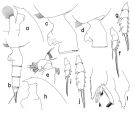 issued from : T. Park in Bull. Scripps Inst. Oceanogr. Univ. California, San Diego, 1995, 29. [p.145, Fig.35]. Female: a, forehead (left side); b, urosome (left); c, genital somite (left); d, idem (left, tilted counterclockwise); e, Mx1 (first inner lobe omitted), posterior; f, exopod of P1 (anterior); g, exopod of P2 (anterior). Nota: Similar in habitus to P. scotti and P.aequatorialis. Laterally, forehead anterior to suprafrontal sensilla almost straight; Urosome relatively slender. Dorsal wall of genital somite with a large hump posterior to middle. Posterior lobe of genital flange and posterior edge of genital field about on same level. Posterior margin of genital prominence aboyt 1/3 length of posterior ventral wall of somite and almost perpendicular to it. Posterior ventral wall of somite strongly bulging. A low, rounded ridge close to anterior margin of genital prominence and a similar ridge close to posterior margin on each side of genital somite. Cephalosomal appendages similar to those of P. aequatorialis with a minor exception that 1st endopodal segment of Mx1 carrying 6 or 7 setae. Male: h, forehead (left); i, exopod of P1 (anterior); j, exopod of P2 (anterior); k, distal exopodal segments of left 5th leg (lateral, tilted clockwise); l, serrated lamella of left 5th leg exopod (anterior, tilted counterclockwise).
|
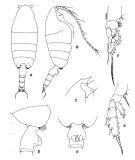 issued from : T. Park in Antarctic Res. Ser. Washington, 1978, 27. [p.273, Fig.113]. As Euchaeta rasa. Female: A, habitus (dorsal); B, idem (right side); C, forehead (lateral); D, E, last metasomal and genital segments (lateral and ventral, respectively); F, P1; G, P2. P1-2: legs (anterior). Nota from Bradford & al. (1983, p.51): - P1 exopod female: Bb = 1/2 BC; Cc > BC. - P2 exopod female: Aa = Ab; Bb = 1/2 BC; Cc = 6/1 CD; Dd = 1/3 CD. (see code of lengths outer spines in the Genus' figure, or in Paraeuchaeta sp. A).
|
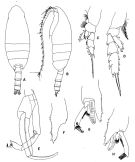 issued from : T. Park in Antarctic Res. Ser. Washington, 1978, 27. [p.274, Fig.114]. As Euchaeta rasa. Male: A, B, habitus (dorsal and lateral, respectively); C, P1; D, P2; E, P5; F, serrated lamella of left P5 (anterolateral); G, H, distal part of exopod of left P5 (medial and anterolateral, respectively). P1-P5: legs (anterior). Nota from Bradford & al. (p.51): - P1 exopod male: Bb = 1/3 BC; Cc = 1/2 BC. - P2 exopod male: Aa = 1/4 AB; Bb = 1/3 BC; Cc = 1/2 CD; Dd = 1/3 CD. (see code of lengths outer spines in the Genus' figure, or in Paraeuchaeta sp. A).
|
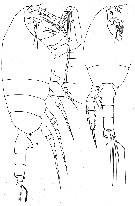 issued from : W. Vervoort in B.A.N.Z. Antarctic Reseach Expedition, Report Ser. B, Vol. III., 1957 [Fig.58]. As Euchaeta rasa. Female (from 66°30'S, 61°08'E): a, habitus (lateral); b, forehead (lateral); c, posterior part cephalothorax and urosome (dorsal). Rostrum slender and tapers gradually into a fine point, directed obliquely forwards.
|
 issued from : W. Vervoort in B.A.N.Z. Antarctic Reseach Expedition, Report Ser. B, Vol. III., 1957 [Fig.59]. As Euchaeta rasa. Female: a-c, genital somite (lateral; right side and left side, respectively); b, posterior part cephalothorax and urosome (lateral). Nota: The genital flaps are not fully symmetrical; the left flap is slightly smaller and less evenly rounded than that on the right side; the caudal slope of the genital elevation, near the base of the flaps, has a strong, chitinous, transverse ridge.
|
 Paraeuchaeta rasa Paraeuchaeta rasa Female: 1 - See key to species Groups and independent species of Paraeuchaeta (p.30): malayensis species Group. 2 - Outer spine of 2nd exopodal segment (or the 2nd of the first 2 exopodal segments forming a proximal, compound segment) of P1 normally developed (Fig.35-f). 3 - Outer lobe of Mx1 with 5 long setae (Fig.35-e). 4 - Laterally, genital prominence low with more or less convex genital flanges. 5 - Laterally, rostrum well developed (Fig.35-a). 6 - Laterally, posterior margin of genital prominence distinct from posterior ventral wall of somite (Fig.35-c). 7 - Genital somite without conspicuous conical process on left side (Fig.35-c). 8 - Laterally, genital prominence with 2 conspicuous semi-circular ridges (Fig.35-c).
|
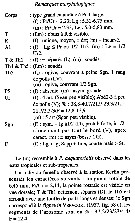 Issued from : C. Razouls in Ann. Inst. océanogr., Paris, 1994, 70 (1). [p.95]. Caractéristiques morphologiques de Paraeuchaeta rasa femelle et mâle adultes. Terminologie et abbréviations: voir à Calanus propinquus.
| | | | | Ref. compl.: | | | Sewell, 1948 (p.574); Errhif & al., 1997 (p.422); Razouls & al., 2000 (p.343, tab. 3, 5, Appendix); Ward & Shreeve, 2001 (p.50, tab. 4); Schnack-Schiel & al., 2008 (p.1045: Tab.2); Park & Ferrari, 2009 (p.143, Table 3, 7: common deep water species, 8, fig.1, Appendix 1, biogeography); Laakmann & al., 2009 (p.679, fig.2, 4, Table 2); Laakmann & al., 2012 (p.535, Table 1, fig.2, Rem.: mol. Biol.) | | | | NZ: | 6 | | |
|
Carte de distribution de Paraeuchaeta rasa par zones géographiques
|
| | | | | | | | | 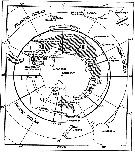 issued from : W. Vervoort in B.A.N.Z. Antarctic Reseach Expedition, Reports - Ser. B, Vol. III, 1957 [Fig.57]. As Euchaeta rasa. issued from : W. Vervoort in B.A.N.Z. Antarctic Reseach Expedition, Reports - Ser. B, Vol. III, 1957 [Fig.57]. As Euchaeta rasa.
Chart showing the geographical distribution (white triangle) in the seas surrounding the Antarctic continent.
Nota: In this chart the area frequented by whaling vessels has been hatched. The Antarctic circle (66°.5 S) has been drawn as a broken line. The numbers I to VI refer to the sectors into which the Antarctic seas are divided according to Mackintosh (1942) (after Vervoort, 1951). |
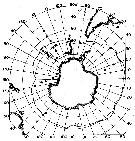 issued from : T. Park in Biology of the Antarctic Seas VII. Antarctic Res. Ser., 1978, 27 (4). [p.259, Fig.104]. issued from : T. Park in Biology of the Antarctic Seas VII. Antarctic Res. Ser., 1978, 27 (4). [p.259, Fig.104].
Occurrence of Euchaeta ( = Paraeuchaeta ) rasa.
Closed circles: stations where the species was found; A.C: Antarctic Convergence. |
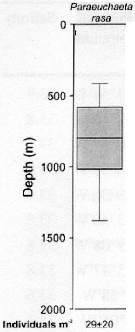 issued from : S. Laakmann, M. Stumpp & H. Auel in Polar Biol., 2009, 32. [p.682, Fig.2]. issued from : S. Laakmann, M. Stumpp & H. Auel in Polar Biol., 2009, 32. [p.682, Fig.2].
Vertical distribution (stages C3 to C6 from Antarctic Polar Front: Atlantic sector).
Error bars encompass the 5th to the 95th percentile. Abundance data are given as mean ± SD.
This species and P.biloba co-occured within the same depth range, and overlapped in their ranges with P. antarctica. |
| | | | Loc: | | | Antarct. ( Weddell Sea, SW Atlant., Indian, SW & SE Pacif., Croker Passage), South Georgia, sub-Antarct. (SW & SE Atlant., SE Pacif.), S Indian (subtropical convergence), Atlant. (SE & SW), Chile | | | | N: | 16 | | | | Lg.: | | | (3) F: 6,4-5,8; M: 5,8-5; (20) F: 6,75-5,31; M: 5,83-5; (25) F: 6,08-5,88; (35) F: 6-5,8; {F: 5,31-6,75; M: 5,00-5,83} | | | | Rem.: | méso-bathypélagique.
Sampling depth (Antarct., sub-Antarct.) : 0-600-4000 m.
Voir aussi les remarques en anglais | | | Dernière mise à jour : 27/01/2017 | |
|
|
 Toute utilisation de ce site pour une publication sera mentionnée avec la référence suivante : Toute utilisation de ce site pour une publication sera mentionnée avec la référence suivante :
Razouls C., Desreumaux N., Kouwenberg J. et de Bovée F., 2005-2025. - Biodiversité des Copépodes planctoniques marins (morphologie, répartition géographique et données biologiques). Sorbonne Université, CNRS. Disponible sur http://copepodes.obs-banyuls.fr [Accédé le 29 novembre 2025] © copyright 2005-2025 Sorbonne Université, CNRS
|
|
 |
 |














